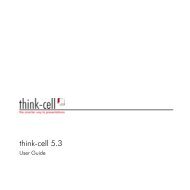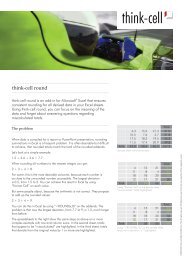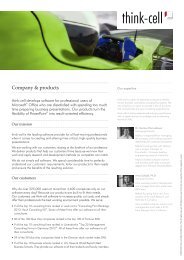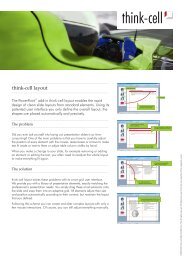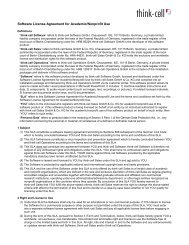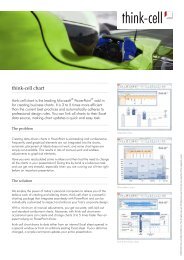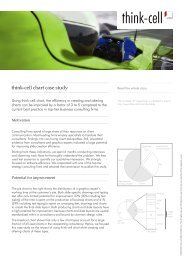think-cell technical report TC2003/01 A GUI-based Interaction ...
think-cell technical report TC2003/01 A GUI-based Interaction ...
think-cell technical report TC2003/01 A GUI-based Interaction ...
You also want an ePaper? Increase the reach of your titles
YUMPU automatically turns print PDFs into web optimized ePapers that Google loves.
4.2 <strong>Interaction</strong> Toolbox INTERACTION CONCEPT<br />
4.2.1 Usability Metrics and Design Objectives<br />
In an attempt to understand the very general concept of usability, I suggest the<br />
definition from ISO 9241 as found in [DFAB98]:<br />
“By usability we mean the effectiveness, efficiency and satisfaction with<br />
which specified users achieve specified goals in particular environments.”<br />
Effectiveness. “The accuracy and completeness with which specified users can<br />
achieve specified goals in particular environments.”<br />
For example, a fork is not effective to eat soup with. Effectiveness comes<br />
before efficiency: If a goal cannot be achieved at all, it can certainly not<br />
be achieved with any reasonable amount of resources. On the other hand,<br />
although I have doubts about its efficiency, Microsoft PowerPoint is definitely<br />
effective for the creation of slides. This is proven by the sheer amount of<br />
PowerPoint presentations that have been created to date.<br />
Efficiency. “The resources expended in relation to the accuracy and completeness<br />
of goals achieved.”<br />
For example, I claim that PowerPoint is inefficient if perfectly aligned layout<br />
is the goal, because the pixel-oriented layout specification can be either fast<br />
or accurate, but hardly both at the same time.<br />
Satisfaction. “The comfort and acceptability of the work system to its users and<br />
other people affected by its use.”<br />
It is certainly desirable that the use of software does not adversely affect<br />
people’s health and it is also proven that constant dissatisfaction has negative<br />
impact on productivity and creativity. Therefore, it’s the developers’ job to<br />
create software that is not only highly effective and efficient, but also makes<br />
the user feel in good hands and pleases her from an aesthetic point of view.<br />
Effectiveness, efficiency and satisfaction set the goals for a usable interface; how-<br />
ever, these terms do not say anything about how the goals can be reached. There<br />
are a myriad of terms, methods and rules that describe the characteristics of “good<br />
usability”. The following design objectives subsume some of the most important<br />
aspects of usable software (again, quoted from [DFAB98]).<br />
Learnability. “The ease with which new users can begin effective interaction and<br />
achieve maximal performance.”<br />
For the present work, this objective requests that skilled PowerPoint users<br />
should be able to use the smart grid with little training or instruction. To<br />
achieve this, all the functionality already known from plain PowerPoint must<br />
behave exactly the same with or without the add-in. The behavior of any ad-<br />
ditional UI components should be modelled after the example of the existing<br />
PowerPoint user interface, but it might be helpful to make new features visu-<br />
ally distinctive from the original PowerPoint, so that the user can easily tell<br />
43



